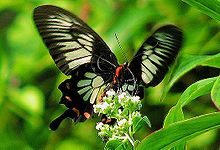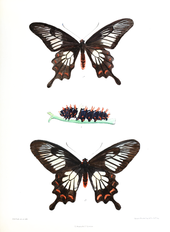Pachliopta jophon
| Ceylon rose | |
|---|---|

| |
| Scientific classification | |
| Domain: | Eukaryota |
| Kingdom: | Animalia |
| Phylum: | Arthropoda |
| Class: | Insecta |
| Order: | Lepidoptera |
| Family: | Papilionidae |
| Genus: | Pachliopta |
| Species: | P. jophon
|
| Binomial name | |
| Pachliopta jophon Gray, [1853]
| |
| Synonyms | |
|
Atrophaneura jophon | |
Pachliopta jophon, the Ceylon rose or Sri Lankan rose, is a butterfly found in Sri Lanka that belongs to the swallowtail family. It was earlier classified as a subspecies of Pachliopta hector, the crimson rose.
It is endemic to Sri Lanka, confined to the rain forests of the central hill country in the south-west.
Description
[edit]
The male upperside is black. The forewing has three or four broad white streaks in a cell and a variable number of similar somewhat broader streaks that are bifid along their apical half in the interspaces beyond; these streaks do not reach the terminal margin and become obsolete towards the costal margin of the wing. The hindwing is in the apical half of the cell and short apically truncate streaks in the interspaces beyond white; these broad streaks broad are divided only by the black veins, followed by a subterminal curved series of crimson lunules irrorated with black scales. The underside is similar, the markings more distinct and more sharply defined; the discal white streaks and the subterminal series of crimson spots are each seven in number. The antennae, head, thorax, and abdomen above up to the pre-anal segment are black; the head in front and beneath, the thorax at the sides and the apical half of the abdomen crimson, the last with one or two black lateral spots. The female is similar, but the forewing is broader, the white and crimson markings larger and more conspicuous.[4]
Status
[edit]It is critically endangered, declining due to loss of habitat.[5]
See also
[edit]Cited references
[edit]- ^ Fernando, E.; Jangid, A.K.; Alwis, C.; Jayasinghe, H.D.; Moonen, J.; Rajapakshe, S.S. (2019). "Pachliopta jophon". IUCN Red List of Threatened Species. 2019: e.T197314A122602081. doi:10.2305/IUCN.UK.2019-3.RLTS.T197314A122602081.en. Retrieved 18 November 2021.
- ^ "Appendices | CITES". cites.org. Retrieved 2022-01-14.
- ^ Rajapakshe, Sarath; Jayasinghe, Himesh; Alwis, Chamitha; Jangid, Ashish; Moonen, Jan; Fernando (ZSL), Eresha (2019-02-28). "IUCN Red List of Threatened Species: Pachliopta jophon". IUCN Red List of Threatened Species. doi:10.2305/iucn.uk.2019-3.rlts.t197314a122602081.en. S2CID 241024470. Retrieved 2021-05-20.
- ^ Bingham, C.T. (1907). The Fauna of British India, Including Ceylon and Burma. Vol. II (1st ed.). London: Taylor and Francis, Ltd.
- ^ Collins, N. Mark; Morris, Michael G. (1985). Threatened Swallowtail Butterflies of the World: The IUCN Red Data Book. Gland & Cambridge: IUCN. ISBN 978-2-88032-603-6 – via Biodiversity Heritage Library.
References
[edit]- Evans, W.H. (1932). The Identification of Indian Butterflies (2nd ed.). Mumbai, India: Bombay Natural History Society.
- Gaonkar, Harish (1996). Butterflies of the Western Ghats, India (including Sri Lanka) - A Biodiversity Assessment of a Threatened Mountain System. Bangalore, India: Centre for Ecological Sciences.
- Kunte, Krushnamegh (2000). Butterflies of Peninsular India. India, A Lifescape. Hyderabad, India: Universities Press. ISBN 978-8173713545.
- Smart, Paul 1976 The Illustrated Encyclopedia of the Butterfly World in Color.London, Salamander:Encyclopedie des papillons. Lausanne, Elsevier Sequoia (French language edition)ISBN 9780948427046 ISBN 0600313816 page 159 fig. 11 (Ceylon).
- Wynter-Blyth, Mark Alexander (1957). Butterflies of the Indian Region. Bombay, India: Bombay Natural History Society. ISBN 978-8170192329.
External links
[edit]- Gimenez Dixon, M. (1996). "Atrophaneura jophon". IUCN Red List of Threatened Species. 1996: e.T2376A9435718. doi:10.2305/IUCN.UK.1996.RLTS.T2376A9435718.en. Retrieved 18 November 2021.
- ARKive Photos
- srilankabutterflies.net Photos and descriptions
- srilankaninsects.net Photos and descriptions

